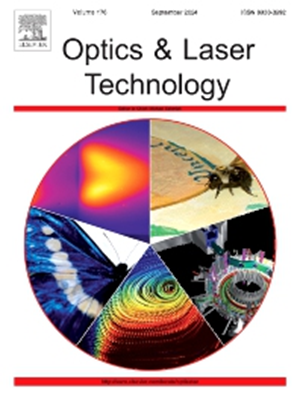基于双光纤光栅的机器人手指多参数触觉传感与识别
IF 5
2区 物理与天体物理
Q1 OPTICS
引用次数: 0
摘要
为了同时识别温度、表面粗糙度和二维形状,提出了一种基于双折射光纤布拉格光栅(Bi-FBG)的多参数触觉传感系统。该系统嵌入机器人的手指中,跟踪手指的运动,增强触觉感知能力。在传感系统中,利用双光纤光栅的双峰传感特性,有效地解耦了温度和应变信息。采用KTx = 0.0192 nm/°C, KTy = 0.0180 nm/°C, Kεx = Kεy = 0.00121 nm/με对Bi-FBG传感器进行标定。同时,采用小波变换和最小矩形法对多向动态滑动的应变信号进行分析。这使得重建物体边界和提取表面粗糙度信息成为可能。实验结果表明,该传感系统能够区分粗糙度等级,重建二维形状,相对误差为0.02,并实现高精度温度测量。该研究证明了该系统具有高精度、多参数的触觉感知能力,拓宽了机器人传感技术的应用前景。本文章由计算机程序翻译,如有差异,请以英文原文为准。
Multi-parameter tactile sensing and recognition for robotic finger based on Bi-FBG
In order to identify the temperature, surface roughness and two-dimensional (2D) shape simultaneously, a multi-parameter tactile sensing system based on birefringent fiber Bragg grating (Bi-FBG) is proposed. The system is embedded in a robotic finger and follows the motion of finger to enhance tactile sensing capabilities. In the sensing system, the dual-peak sensing characteristics of Bi-FBG are employed to effectively decouple temperature and strain information. The Bi-FBG sensor was calibrated with KTx = 0.0192 nm/°C, KTy = 0.0180 nm/°C, and Kεx = Kεy = 0.00121 nm/με. Meanwhile, wavelet transform and least rectangles method are used to analyze strain signals from multi-directional dynamic sliding. This enables reconstruction of the object boundaries and extraction of the surface roughness information. The experimental results show that the sensing system can distinguish roughness levels, reconstruct 2D shapes with a relative error of 0.02, and achieve high-precision temperature measurement. This study demonstrates the system’s capability for high-precision, multi-parameter tactile perception and broadens the application prospects of robotic sensing technology.
求助全文
通过发布文献求助,成功后即可免费获取论文全文。
去求助
来源期刊
CiteScore
8.50
自引率
10.00%
发文量
1060
审稿时长
3.4 months
期刊介绍:
Optics & Laser Technology aims to provide a vehicle for the publication of a broad range of high quality research and review papers in those fields of scientific and engineering research appertaining to the development and application of the technology of optics and lasers. Papers describing original work in these areas are submitted to rigorous refereeing prior to acceptance for publication.
The scope of Optics & Laser Technology encompasses, but is not restricted to, the following areas:
•development in all types of lasers
•developments in optoelectronic devices and photonics
•developments in new photonics and optical concepts
•developments in conventional optics, optical instruments and components
•techniques of optical metrology, including interferometry and optical fibre sensors
•LIDAR and other non-contact optical measurement techniques, including optical methods in heat and fluid flow
•applications of lasers to materials processing, optical NDT display (including holography) and optical communication
•research and development in the field of laser safety including studies of hazards resulting from the applications of lasers (laser safety, hazards of laser fume)
•developments in optical computing and optical information processing
•developments in new optical materials
•developments in new optical characterization methods and techniques
•developments in quantum optics
•developments in light assisted micro and nanofabrication methods and techniques
•developments in nanophotonics and biophotonics
•developments in imaging processing and systems

 求助内容:
求助内容: 应助结果提醒方式:
应助结果提醒方式:


